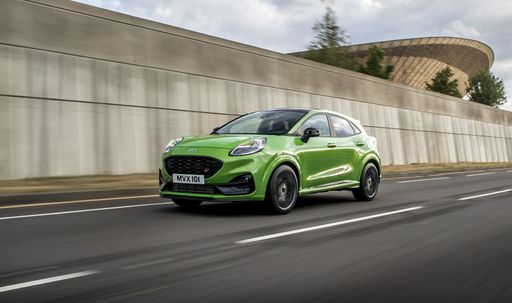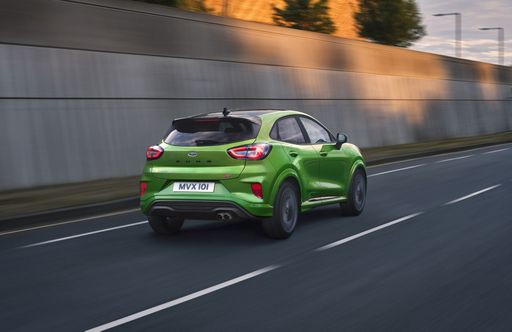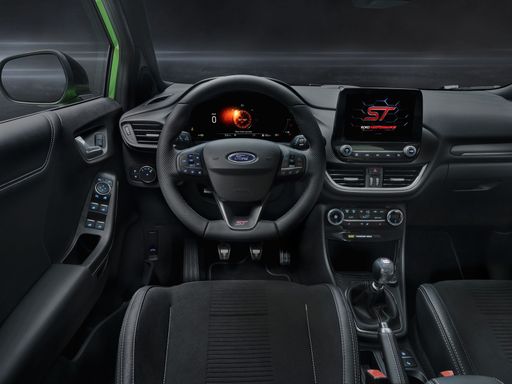Ford Puma vs Kia EV4 Hatchback – Differences & prices compared
Compare performance, boot space, consumption and price in one view.
Find out now: which car is the better choice for you – Ford Puma or Kia EV4 Hatchback?
The Ford Puma (SUV) comes with a Petrol MHEV or Electric engine and Manuel or Automatic transmission. In comparison, the Kia EV4 Hatchback (Hatchback) features a Electric engine with Automatic transmission.
When it comes to boot capacity, the Ford Puma offers 523 L, while the Kia EV4 Hatchback provides 435 L – depending on how much space you need. If you’re looking for more power, decide whether the 168 HP of the Ford Puma or the 204 HP of the Kia EV4 Hatchback suits your needs better.
In terms of consumption, the values are 13.10 kWh5.40 L per 100 km for the Ford Puma, and 14.90 kWh for the Kia EV4 Hatchback.
Price-wise, the Ford Puma starts at 24800 £, while the Kia EV4 Hatchback is available from 32200 £. Compare all the details and find out which model fits your lifestyle best!
Ford Puma
The Ford Puma presents itself as a stylish compact SUV with a distinctive design that combines practicality with a dynamic driving experience. Its sleek lines and sporty aesthetics make it stand out on the road, while the interior offers a comfortable and tech-savvy environment. With an emphasis on efficiency and a smooth drive, the Ford Puma is well-suited for both urban commutes and countryside adventures.
details @ puma.fordpresskits.com
@ puma.fordpresskits.com
 @ puma.fordpresskits.com
@ puma.fordpresskits.com
 @ puma.fordpresskits.com
@ puma.fordpresskits.com
 @ puma.fordpresskits.com
@ puma.fordpresskits.com
Kia EV4 Hatchback
The Kia EV4 Hatchback paves the way for a sleek and efficient driving experience, capturing attention with its modern design and eco-friendly performance. Built with comfort and sustainability in mind, this hatchback redefines electric mobility for urban explorers and suburban commuters alike. Inside, the EV4 boasts a spacious and tech-savvy interior, offering drivers and passengers a seamless blend of innovation and practicality.
details

|
|
|
|
|
Costs and Consumption |
|
|---|---|
|
Price
24800 - 36300 £
|
Price
32200 - 42400 £
|
|
Consumption L/100km
5.4 - 6 L
|
Consumption L/100km
-
|
|
Consumption kWh/100km
13.1 - 13.7 kWh
|
Consumption kWh/100km
14.9 - 16.2 kWh
|
|
Electric Range
364 - 376 km
|
Electric Range
440 - 625 km
|
|
Battery Capacity
43 kWh
|
Battery Capacity
58.3 - 81.4 kWh
|
|
co2
0 - 136 g/km
|
co2
0 g/km
|
|
Fuel tank capacity
42 L
|
Fuel tank capacity
-
|
Dimensions and Body |
|
|---|---|
|
Body Type
SUV
|
Body Type
Hatchback
|
|
Seats
5
|
Seats
5
|
|
Doors
5
|
Doors
5
|
|
Curb weight
1316 - 1563 kg
|
Curb weight
1811 - 1910 kg
|
|
Trunk capacity
456 - 523 L
|
Trunk capacity
435 L
|
|
Length
4186 - 4226 mm
|
Length
4430 - 4450 mm
|
|
Width
1805 mm
|
Width
1860 mm
|
|
Height
1550 - 1555 mm
|
Height
1485 mm
|
|
Payload
367 - 469 kg
|
Payload
445 - 459 kg
|
Engine and Performance |
|
|---|---|
|
Engine Type
Petrol MHEV, Electric
|
Engine Type
Electric
|
|
Transmission
Manuel, Automatic
|
Transmission
Automatic
|
|
Transmission Detail
Manual Gearbox, Dual-Clutch Automatic, Reduction Gearbox
|
Transmission Detail
Reduction Gearbox
|
|
Drive Type
Front-Wheel Drive
|
Drive Type
Front-Wheel Drive
|
|
Power HP
125 - 168 HP
|
Power HP
204 HP
|
|
Acceleration 0-100km/h
7.4 - 9.8 s
|
Acceleration 0-100km/h
7.4 - 7.8 s
|
|
Max Speed
160 - 210 km/h
|
Max Speed
170 km/h
|
|
Torque
170 - 290 Nm
|
Torque
283 Nm
|
|
Number of Cylinders
3
|
Number of Cylinders
-
|
|
Power kW
92 - 124 kW
|
Power kW
150 kW
|
|
Engine capacity
999 cm3
|
Engine capacity
-
|
General |
|
|---|---|
|
Model Year
2024 - 2025
|
Model Year
2025
|
|
CO2 Efficiency Class
D, E, A
|
CO2 Efficiency Class
A
|
|
Brand
Ford
|
Brand
Kia
|
Ford Puma
A Glimpse into the Ford Puma: Fusing Style with Innovation
The Ford Puma stands as a testament to modern engineering fused with style. This compact SUV is not just about aesthetics but brings to the table an array of technical innovations, topped with the reliability and performance Ford is known for. Let's delve into the technical specifics and innovative features that make the Ford Puma a stellar choice for any car enthusiast.
Powertrains and Performance
The Ford Puma is offered with a range of powertrains designed to deliver optimal performance whilst minimising fuel consumption. At the heart of this compact SUV is the 1.0 EcoBoost Hybrid engine, available in both 125 PS and 155 PS variants. This engine is a marvel of engineering, optimised to deliver power efficiently with a remarkable fuel consumption ranging from 5.4 to 5.7 L/100km for manual versions, and slightly higher for the automated variants.
The top-end 1.5 EcoBoost ST variant takes performance up a notch, providing a robust 200 PS that propels the Puma from 0 to 100 km/h in just 6.7 seconds. This variant is perfect for those who prioritise performance and exhilaration in their driving experience.
Mild-Hybrid Technology
The Puma's mild-hybrid technology plays a significant role in enhancing fuel efficiency and reducing emissions. By utilising a belt-driven integrated starter/generator, the Puma recovers energy usually lost during braking, storing it in a 48-volt lithium-ion battery. This stored energy is then used to assist the engine, providing a boost during acceleration and smoothing out the stop-start technology, ultimately leading to enhanced fuel efficiency.
Design and Comfort
The Ford Puma does not compromise on style and comfort with its ergonomic and stylish design. The SUV is available in multiple trims including the ST-Line, Titanium, and the luxurious Vignale editions, each offering unique aesthetic and technological enhancements. These trim levels provide varied offerings in terms of both exterior styling and interior comfort, ensuring there's a Puma that meets every personal preference.
Inside, the Puma offers a driver-focused cockpit with advanced technological integrations such as the SYNC 3 infotainment system, providing seamless connectivity and intuitive control of the vehicle's numerous technological features.
Safety and Technology
Safety remains paramount, and the Ford Puma is equipped with the latest security and technology features. It boasts the Ford Co-Pilot360 suite which includes adaptive cruise control, pre-collision assist with autonomous emergency braking, and lane-keeping assist, enabling a safer driving experience on both city roads and highways.
Versatility and Practicality
Beyond performance and safety, the Ford Puma shines in its versatility. With a boot capacity of 456 litres, it offers ample space for all sorts of adventures, whether you're heading on a family trip or loading sports equipment. Its innovative MegaBox is an extra storage solution, providing additional space below the boot floor.
The Puma's agile handling, paired with its compact dimensions—spanning a length of 4186 to 4266 mm and a width of 1805 mm—makes it an ideal choice for urban commuting and beyond.
Conclusion
In conclusion, the Ford Puma beautifully blends practical features with cutting-edge technology, offering a package that appeals to both the tech-savvy driver and those seeking comfort and reliability. Its range of innovative features, powerful yet efficient engine options, and a design that is both functional and stylish make it a frontrunner in the compact SUV market.
Whether you're drawn by the efficient mild-hybrid engines or the robust performance of the ST variant, the Ford Puma represents a modern driving experience where innovation meets everyday usability.
Kia EV4 Hatchback
The Future is Electric: Introducing the Kia EV4 Hatchback
As the automotive industry rapidly pivots towards sustainable solutions, the Kia EV4 Hatchback emerges as a beacon of innovation and efficiency in the electric vehicle (EV) segment. Designed for the conscientious driver who desires both functionality and flair, this model promises to set a new standard for what an electric hatchback can be.
Electrifying Performance
The heart of the Kia EV4 Hatchback is its cutting-edge electric powertrain. Equipped with a robust 150 kW electric motor, this vehicle delivers an impressive 204 horsepower, ensuring a zippy yet smooth ride. With a maximum torque of 283 Nm, drivers can confidently navigate both city streets and open highways, benefiting from immediate power delivery typical of electric motors.
Battery Options and Range
The Kia EV4 offers versatility with two key battery configurations—58.3 kWh and 81.4 kWh options. The former caters to drivers who prioritize city commuting with a substantial range up to 440 km, while the latter extends capabilities to a robust 625 km, perfect for longer, uninterrupted journeys. These batteries ensure that the EV4 can fit diverse lifestyle needs without the constant worry of recharging.
Efficiency that Excels
Efficiency remains a cornerstone for the Kia EV4, with consumption rates as low as 14.9 kWh/100 km. Such figures ensure reduced energy usage while maintaining performance, aiding both the environment and cost-effectiveness for the user. The model's acceleration is notable too, reaching 0-100 km/h between 7.4 to 7.8 seconds, delivering a balance of power and prudence.
Smart Design and Spacious Comfort
The EV4’s design epitomizes modernity, seamlessly combining aesthetic charm with practical functionality. At a length between 4430 mm to 4450 mm, with a width of 1860 mm, this hatchback offers optimal road presence. Rear passenger access is optimized with five doors, adding convenience without compromising the vehicle’s streamlined appearance. Whether it is family travel or personal commuting, the 435-liter trunk capacity accommodates various storage needs.
Safety and Sustainability
In alignment with Kia's commitment to sustainability, the EV4 Hatchback boasts a CO2 efficiency class of A, indicative of its environmentally conscious engineering. The zero-emission credentials of this hatchback underscore its role in promoting cleaner transport solutions. Safety hasn't been compromised either, with the latest in automotive technology incorporated to ensure peace of mind with every drive.
Conclusion: A Vision for Tomorrow’s Mobility
The Kia EV4 Hatchback isn't just a vehicle; it's a statement of intent for a new era of mobility. Its blend of power, precision, and eco-friendliness stands as a benchmark for EVs, demonstrating that reducing environmental impact doesn't mean sacrificing performance or style. As the world embraces electric mobility, the Kia EV4 Hatchback is well-positioned to thrive, offering an exhilarating, sustainable driving experience to individuals and families alike.
What drivetrain options does the Ford Puma have?
Available configurations include Front-Wheel Drive.
The prices and data displayed are estimates based on German list prices and may vary by country. This information is not legally binding.
